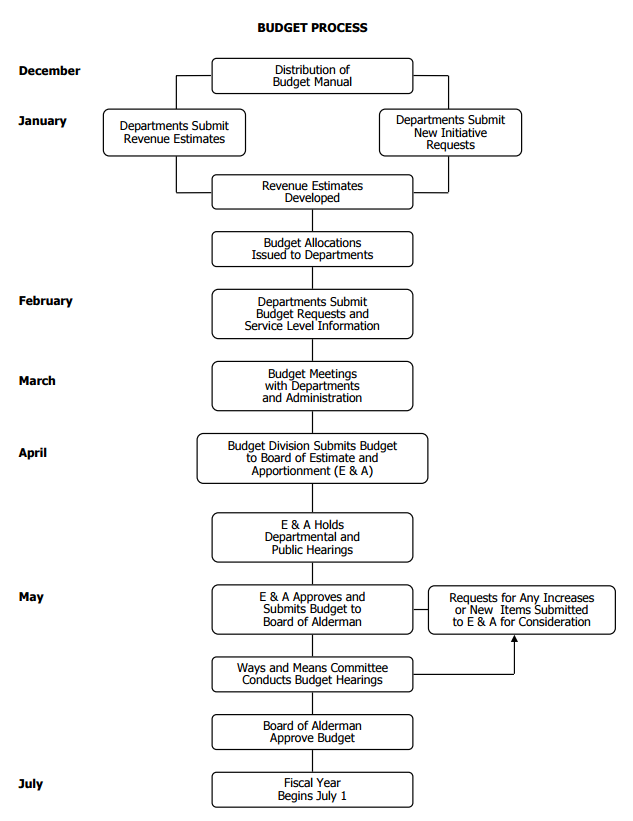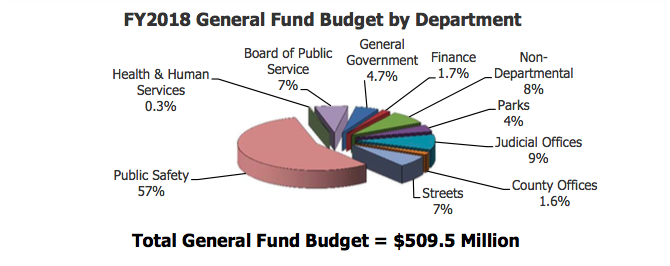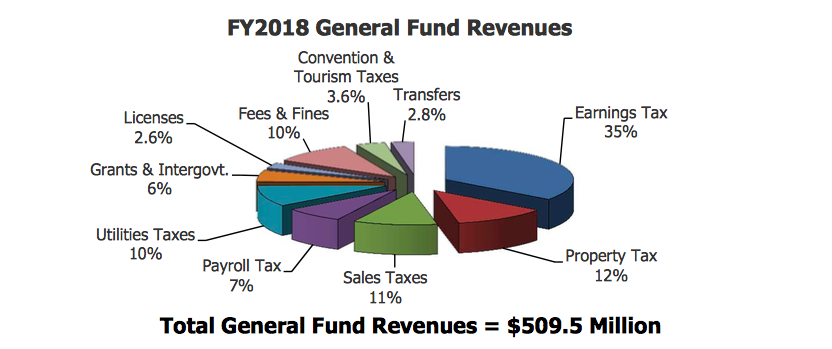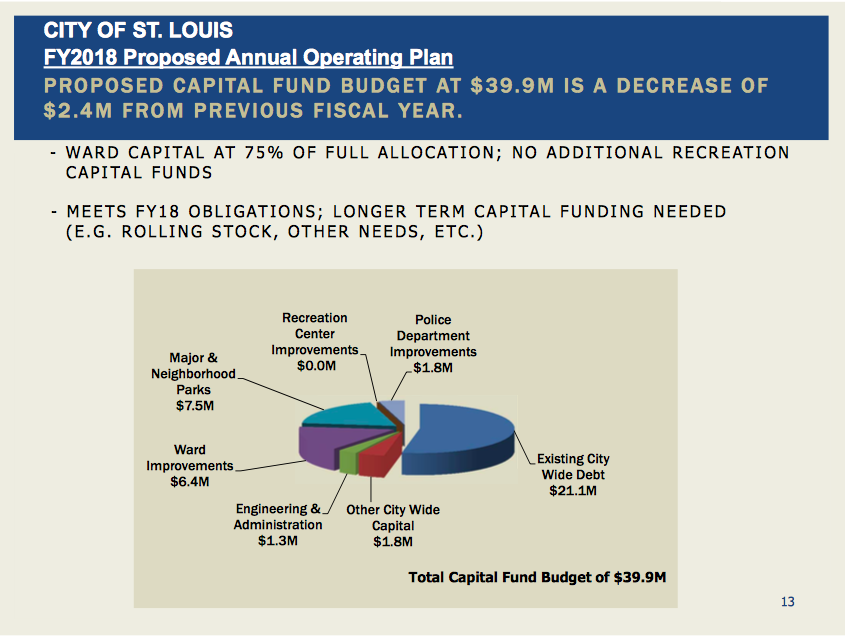At the Board of Estimates and Appointment (E&A) meeting on Wednesday, April 19, Paul Payne, director of the city’s budget division, presented Fiscal Year 2018’s proposed Annual Operating Plan (aka St. Louis City’s budget). It’s easy to get stuck in the weeds understanding this one, so we’ll try to break it down, and point out a few highlights.
The Current State of the Budget
- The city’s proposed operating budget for FY2018 totals $1.053 Billion.
- Overall, the budget is up 1.1%, compared to last year, although there seem to be two different percentages given on different pages
- The budget deficit is currently $17M. This is a slight improvement over last years’ $20M shortfall at the beginning of the budgeting process. While the deficit is getting smaller, Mr. Payne emphasized that the city is still not in a good fiscal position should something like a recession occur.
- Just this March the city took a hit with its third credit downgrade over the past several years. This is increasing city costs for borrowing.
- FY18’s general revenue projection ($509.5M) is lower than FY17 ($511.1M), despite an improved economy. Since normal sales tax revenue has not increased, the city’s revenue projections show an increase due to higher sales (and use) tax revenue under the recently approved via Proposition 1. This revenue is under the “Special Revenue & Other Funds” category.
- Revenue growth is continuing at just below 2%, which is the Federal Reserve’s inflationary target.
To address the $17M budget gap, the budget department proposes an overall reduction of spending by $5.5M. Cuts would happen in a variety of departments, including a reduction of 41 city jobs (this is on top of 43 positions cut last year).
Big Potatoes
The following lists break down the proposed FY2018 budget and emphasize points of concern for Team TIF.
Housing and Development
- The budget cuts the Affordable Housing Trust Fund (AHTF) below $5 million statutory minimum, which has been the case, since FY2012. The AHTF’s funding is slated to continue below its legally mandated minimum despite new Use Tax revenue that could help the city reach the Forward Through Ferguson Report’s goal of funding the program above the $5 million statutory minimum.
- The section on “Vibrant and Diverse Economy” consists of two components — TIF projects in the Central Corridor and the National Geospatial Agency (NGA). This does not represent a real diverse economy. The fact that the city’s entire section on a diverse economy consists of highlighting Central Corridor developments and one mega-project demonstrates its still myopic view of economic development.
- The summary mentions higher than expected earnings tax growth, but also lower payroll (the employer portion). A main driver of this phenomenon is likely the overuse of Tax Increment Financing (TIF), a development incentive. TIF payments are diverting so much payroll tax revenue that they are creating a large gap in these two revenue streams, even though they should track rather closely to each other. In other words, employees working in TIF’d buildings are still paying earnings taxes — but their employers who own the buildings are able to use their payroll tax liability to help pay down their TIF debt.
Income: Fees & Taxes
- Earnings Tax revenue is projected to grow by 2.7% in FY18
- Despite increasing home values and sales prices, property tax receipts only increased by 1.2%, trailing the historical trend of higher than 1.5%
- Franchise Utility Tax receipts are down 0.7%. Due to expected utility rate increases by Ameren and Laclede, the city estimates electricity taxes to generate an additional 3.5% and natural gas an additional 3% in FY18.
- This year sales tax receipts decreased by 1.6%, despite a healthier economy. The proposed budget anticipates a 1% growth in FY18.
- Restaurant tax receipts increased 0.3% this year, but the city is projecting a 2% growth rate in FY18. Over this same period, hotel taxes have increased 3.2% and are projected to grow at 3% in FY18.
- The City estimates $750,000 in increased revenue from the St. Louis Metro Police Department’s controversial asset forfeiture program. This is an anticipated 20.1% increase that indicates that the department will continue to focus their efforts on asset forfeiture in the upcoming year.
- Payroll tax showed “little to no growth” this year, and is projected to grow by 1.5% in FY18
- The additional Use Tax is expected to generate $2.3 million in revenue over the 7 months it will be collected
- Y17 Budget estimates fell short in a few areas: uncollected court fees, Sheriff’s fees and a $800,000 shortfall in building permit fees, all of which were be offset by higher revenue that expected from EMS services.
- Airport revenue estimates are mysterious. For some reason, the budget anticipates an increase of 24.4% in airport parking fees. This is far higher than any other increase in airport revenue streams. This may signal an impending increase in parking rates on airport-owned lots.
- The new sales tax passed in April via Proposition 1 is expected to generate $11.2 million in revenue over 7 months of collection.
- Gaming revenue is down $250,000.
Spending Priorities
- The Civilian Oversight Board’s budget remains consistent with last year.
- An additional $460,000 is allocated for police recruitment. Public Safety funding is increased to hire 24 SLMPD uniformed officers.
- A $500,000 increase in food and medical costs in corrections will be paid for by redirecting salary funds away from vacant positions.
- Rising health insurance costs will lead to a 7% increase in premiums paid by the city.
- Debt servicing costs will increase by $2 million.
- This will be the first year reflecting the a projected $4 million in lost yearly revenue from the Scottrade Center renovations.
- The budget cuts $500,000 from recreation capital funds.
- 61% of Capital Improvement Funds money will be allocated towards servicing debts.
- The budget shows a $300,000 decrease in the parks department’s weed control program
- The budget cuts positions across a variety of departments. Examples include job lost at Recorder of Deeds office, five Park Ranger positions, and 12 positions in Refuse.
Note that some of these budget changes are small potatoes (numbers wise) and it is easy to get caught up in them. Be wary of this rhetoric distracting from the bigger picture, large budget items, while also remembering the impact they may have on people’s lives.
What Happens Next?

Budget process flow chart — click to enlarge
The budget process is not finished! Key parts of the budget are still up for debate. Here’s one example:
- At Wednesday’s meeting Estimates and Appointment members (Lewis Reed, Darlene Green, Lyda Krewson) discussed what they want to change in the budget before it goes before the Board of Aldermen today. They all emphasized funding public safety; however, they each proposed differing approaches to accomplish this.
- Krewson: If the budget is passed as it presented at this meeting, the use tax generated by Prop1 (which would have gone to fund the soccer stadium if voters had passed Prop2) would instead go towards balancing the budget. (Currently, it “reduces general fund subsidies”) Krewson says she doesn’t approve of this allocation and is pushing for a restructuring of the budget to free up the new use tax revenue. Based on her previous statements, we can safely assume she wants this allocated towards hiring more police.
- Green: Darlene Green is concerned about reductions in recreation and summer job spending, claiming they are important in keeping youth off the streets. Green proposed “in-house” spending reductions before going to the business community for support. The three of them agreed with her proposal to implement trip spending limits for city wide elected officials to three trips.
- Reed: Reed wants to create more public-private partnerships with downtown corporations to fund budget shortfalls and non-profit work. Examples of “corporate philanthropy” that funnels private money to nonprofit or city services in St. Louis include the United Way of Greater St. Louis and the St. Louis Police Foundation.
The budget needs to go through public hearings (in 2015 & 2016 public meetings were held outside of City Hall) and edits before it can leave Estimates and Appointment on April 26 ahead of the final July 1 approval. We need to increase public input and pressure to ensure that the budget reflects a commitment to racial equity and government transparency, not a continuation of the status quo. It’s not too late to change course.



Discover more